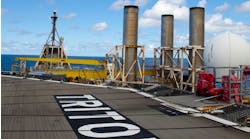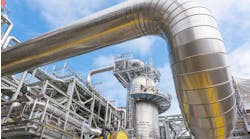Jeremy Beckman
London
The completed Gany-mede platform at the Barmac yard was delivered to Conoco under the budgeted cost.
Troll in line for 600 million bbl extension
A huge upgrade of Troll oil reserves will likely lead to orders for a second floater and drilling of up to 54 new wells. According to operator Norsk Hydro, up to 1 billion bbl may now be recoverable through accessing the thin oil layers of the Troll West Oil and Gas provinces, thanks to advances in extended reach drilling, improved understanding of the reservoir's production characteristics, and analysis of recent 3D seismic.
Original estimates for West Troll oil alone were 420 million bbl. Here, Hydro is putting the finishing touches to the $3 billion Phase I development, scheduled to come onstream this October via Troll B, the world's largest concrete semisubmersible production unit.
A production development order will be presented to Hydro's partners next spring with oil in the north of the Troll Gas province produced probably through another semisubmersible linked to clusters of subsea wells.
In the Haltenbanken, the committee of oil companies planning the $4 billion unitized development of the Smorbukk, Smorbukk Sor and Midgard fields have opted for a production ship for the oil phase. However, hardware for the gas is undecided - it could be either a semisubmersible or a gravity base platform. At peak, oil output would be 220,000 b/d. Production should start via 20 wells in October 1998 (assuming that number can be drilled by then), with gas onstream two years later, peaking at 1.2 billion cu ft per day.
Further FPSOs in prospect
Yet more floaters are possible for four new UK North Sea fields:- Shell has invited tenders for a leased FPSO for its Curlew oil and gas prospect in central block 29/7. The successful contractor may also be asked to provide drilling and completions, a gas export line, subsea trees, and wellheads.
- Amerada Hess is open to suggestions for its Dauntless and Durward oilfields in blocks 21/16 and 21/11, but some sort of FPSO is thought to be on the cards. Appraisal drilling continues on Dauntless, and Amerada is hoping for a fast-track development, possibly producing late next year.
- Texaco wants a leased FPSO for a two-year stint from mid-1996 on an unnamed oil block.
- Enterprise and Marathon may also choose a floater for their Sedgwick and West Brae prospects, although a subsea tie-in to Brae is more likely.
BP is definitely going ahead with its second FPSO-based development west of the Shetlands, for the Schiehallion Field. Various consortia were kept on tenterhooks until BP finally settled on the Atlantic Frontier Alliance, comprising Brown & Root, Single Buoy Moorings, and the Harland and Wolff shipyard in Belfast.
BP arrives at ETAP solution
BP also decided on pre-sanction awards for the Eastern Trough Area Project (ETAP). This covers a group of fields with combined reserves of 400 million bbl of oil, 65 million bbl of gas liquids and 1.45 tcf of gas.
ETAP has been one of the slower-track UK developments, complicated partly by the seven partners' varied interests in the fields. Shell operates three of them. Early production tests were performed on the Machar prospect last year.
The new scheme calls for two small steel platforms in the Marnock Field housing process facilities, utilities and accommodation, with a normally unmanned platform on Mungo. Machar and Monan and the Shell-operated trio of Egret, Heron and Skua would all be tied back to Marnock through subsea manifolds. Peak production would be 200,000 b/d of oil and 580 Mcf/d of gas.
By comparison, the minute Newsham Field (53 bcf) in the Southern Gas Basin has been cleared for an $18 million development by the DTI. This prospect was first discovered by Texaco and Chevron in 1966, with BP gaining control of the block last year. It will be exploited via a subsea horizontal well sidetracked from an existing appraisal well, with the Rotliegendes gas carried by an 8 in. flowline to the West Sole A platform 6 km away.
On the much bigger BP-operated Bruce gasfield, a Phase II development of the western area has had to be postponed once more due to strong reservoir and production performance. Two wells drilled recently were expected to flow, respectively, 160 Mcf/d and 70 Mcf/d with 10,000 b/d of condensate.
Discovery of an oil pool last year in the field's northern section - thought to contain up to 200 million bbl in poor quality sands - has changed the emphasis on the Phase II development. Gas is no longer the sole priority. New options being considered include upgrading water injection and produced water facilities, and maybe adding gas compression to permit oil recovery through gas injection.
This turn of events has probably also delayed development of the nearby small oil and gas Keith Field operated by BHP, which was expected to be tied back subsea to Bruce.
Chevron weighs up Alba Southern options
Other developers in the news include Chevron, gearing up for a production development order at last for Alba Southern. The initial plan is to add extra processing facilities to the Alba Northern platform and drill long reach horizontal wells from there to the Southern reservoir, thought to contain up to 200 million bbl of heavy crude. But processing requirements may call for installation of a second, unmanned platform in the north with a subsea manifold for water injection wells in the south.
Conoco plans to install a compression platform late next year just to the southwest of its Murdoch production platform in the Southern North Sea. This would enhance the Caister-Murdoch gas gathering and transportation system in Quadrant 44, which is also due to take on supplies from Shell's Schooner Field next year. Capacity of this system is currently 750 Mcf/d. There are other potential customers including Total for its Hunter prospect.
Not far away in another Conoco stronghold, the Jupiter fields area, Brown and Root McDermott's yard in Ardersier, Scotland has completed the not-normally-manned platform for the Ganymede Field. This is a fit-for-purpose design with most of the platform systems commisioned ahead of last month's installation to cut costs.
Copyright 1995 Offshore. All Rights Reserved.





